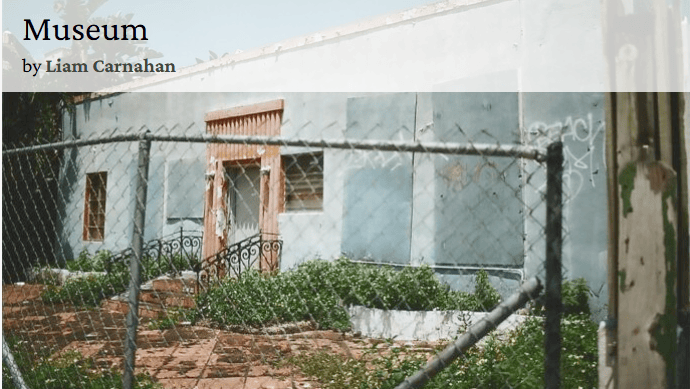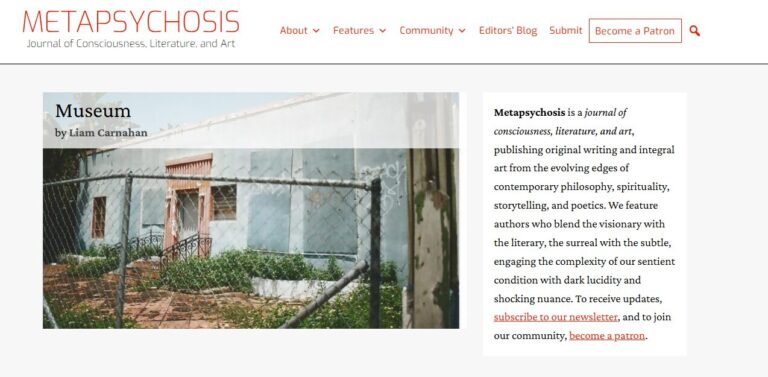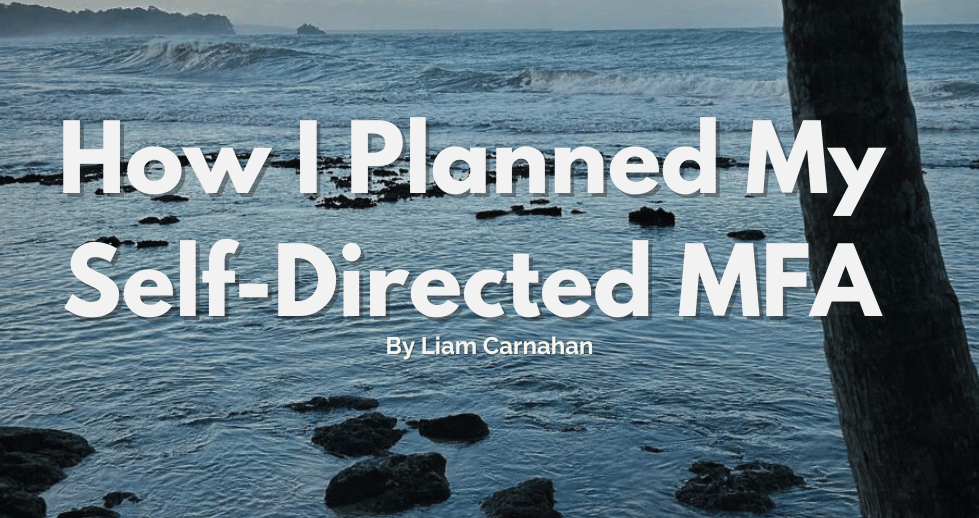A few days ago, I got some very exciting news. For the first time ever, my work was appearing in a literary magazine.
My essay Museum is up now on the online journal Metapsychosis.
You can read it right here.
I’m feeling a blend of pride, shock, relief, and anxiety as I see my name on there. This has been a goal on my writing journey since I restarted it a year and a half ago, and now it’s here.
And also: I’m not done. This is just one publication, but I’m greedy. I want many, many more.
I’m using this blog to chronicle my revitalized writing career, and to help other writers out there map their own journey to publication.
So to that end, I’ll use this article to walk through the evolution of this essay and how it went from a hazy idea to my first publication.
Realizing my need for bylines
Though I’ve been writing and publishing blogs for fifteen years, when I started getting serious about my creative writing back in 2023, I realized I desperately needed some bylines to my name.
I wanted to apply for scholarships, residencies, fellowships, and eventually, agents and editors.
To be a serious contender for any of those—even the ones that advertise themselves as available to emerging writers—I needed some literary street credit.
Residencies don’t want writers who are just looking for a fun vacation with a bit of writing. They want candidates who are serious about the craft and their desire for publication.
Publishing articles on business websites, which is what I do for my main job, wasn’t good enough.
I needed my creative, personal work to be out there in publications that were deemed credible by the literary and publishing community.
And I hadn’t written anything like that since college.
Enrolling in an essay class and getting the “magic prompt”
To solve this dilemma, I enrolled in a class at Grub Street called 6 Essays in 6 Weeks.
The outline for the course was intimidating. Each week, we were expected to come to class with 1,000 words to read out loud to the class, based on an assigned prompt from the previous week.
The class was excellent, and though I ended up skipping twice because I simply couldn’t get 1,000 words out of me, I walked away with four essays that I felt had potential.
More importantly, this class kickstarted my “habit.” It helped me remember how to think about essays, how to be watchful for situations and characters that could turn into essays, and how to polish and revise my work to make it publish-ready. It also helped me find my “essay voice” which is similar but distinct from my “memoir voice.”
The examples and prompts we read in class were immensely helpful. The essay that was published in Metapsychosis spawned from a prompt my teacher created based off a piece by Dinty Moore, editor of Brevity, about the art of writing a “flash essay” (a very short essay).
The piece by Moore is so lovely, I’m reposting part of it here:
Though trying to pin down any art form too strictly is ultimately a fruitless exercise, I’ve come up with what I think is an apt metaphor: Imagine there is a fire burning deep in the forest. In an essay of conventional length, the reader begins at the forest’s edge, and is taken on a hike, perhaps a meandering stroll, into those woods, in search of that fire. The further in the reader goes, with each page that turns, the more the reader begins to sense smoke in the air, or maybe heat, or just an awareness that something ahead is smoldering. In a very brief essay, however, the reader is not a hiker but a smoke jumper, one of those brave firefighters who jump out of planes and land thirty yards from where the forest fire is burning. The writer starts the reader right at that spot, at the edge of the fire, or as close as one can get without touching the actual flame. There is no time to walk in. The brief essay, in other words, needs to be hot from the first sentence, and the heat must remain the entire time. My fire metaphor, it is important to note, does not refer to incendiary subject matter. The heat might come from language, from image, from voice or point-of-view, from revelation or suspense, but there must always be a burning urgency of some sort, translated through each sentence, starting with the first. Judith Kitchen has her own comparison, focusing on ice instead of fire.“I often use a snowball metaphor,” she has said. “You’ve got all this stuff out there called snow but when you gather it all up and really pack it together, you know, and you throw it off, there’s a sting. I think with these short pieces—-even when they're quiet an meditative—-the effect is a little sting.” Fire or ice? Either way, the air changes.
Dinty Moore
The teacher used this excerpt to give us a prompt:
Using one or more of our sample essays as inspiration – or going off entirely on your own – draft a flash nonfiction piece that starts near the “flame” and ends with “a little sting.”
That prompt, along with my deeply rooted need to be a teacher’s pet, inspired me to churn out the first draft of this essay.
In Museum, I start with what I consider to be a flame: a scene where my mother and I break into an abandoned mental hospital.
The second half of the essay brings the ice (I hope). But you will have to read it and tell me if I hit the mark with my snowball.
A self-imposed writer’s retreat
I missed the first class of my Essay course, because I had already made plans for a very exciting mini-vacation with three friends from college.
We booked a sweet little farmhouse tucked in the remote mountains of North Carolina for a long weekend of writing together.
We stocked up on food, made meticulous meal plans and schedules, made the trek from the four corners of the US… and within 48 hours, everyone but me had contracted Covid.
I’m still not sure how I made it out of there without getting the virus. I did my best to keep my distance, while also aching to be with my friends after all this planning.
The upside is that my memoir is about aching to be with friends and missing out on plans because of Covid.
Still not ideal, but inspiration was flowing nonetheless and I got a lot of writing done. Most of it took place as I self-quarantined in the fairy-themed shed in the backyard. As I wrote, a black dog that roamed the property kept me company. We nicknamed him Cerebrus.
But I digress.
After the retreat, I shared the revised copy with my writing groups until I was confident enough to start submitting it.
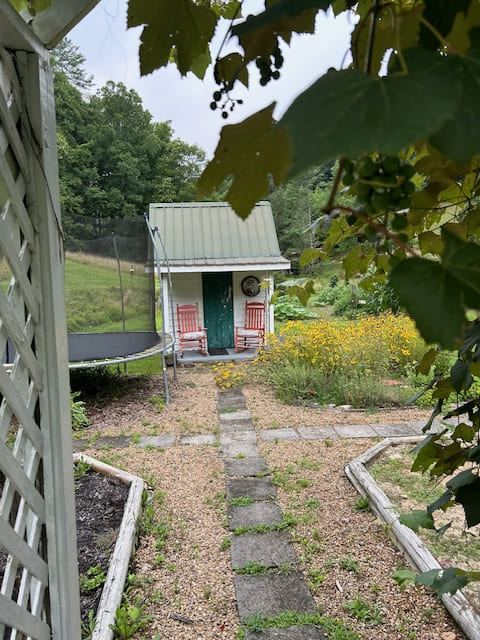
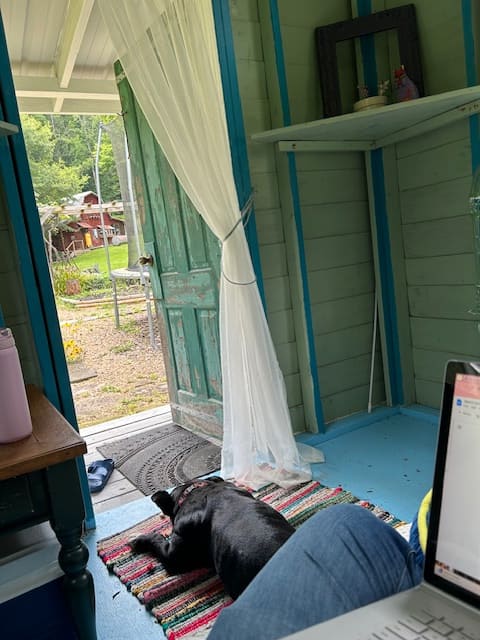
Using Duotrope and Poets & Writers to submit, submit, submit
Through my courses at Grub Street and other writing friends, I’ve learned a lot about the submission process. Specifically how painful it is.
I signed up for a paid account on Duotrope, which is by far the best tool I’ve found for managing submissions.
Its data base is brimming with literary journals, and the search function allows you to hunt for specific magazines looking for your style of writing.
What also appealed to me about Duotrope was its submission tracker. I love a good tracker, and this one allows you to be super meticulous (if you want) about everything from when you submitted, how much you spent, and whether you got a soft rejection, a standard rejection, or never heard back at all.
As you can see, rejections are definitely the most common responses:
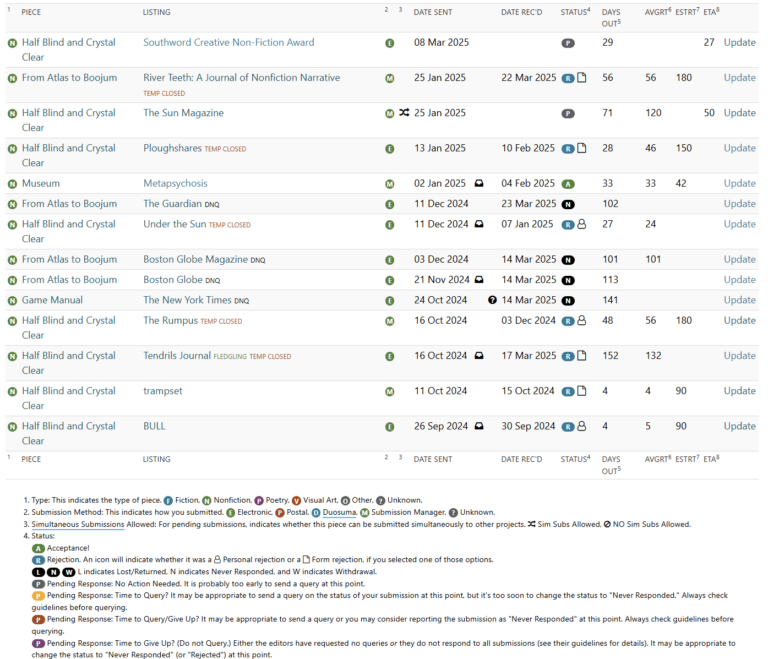
Rejections are part of the game, and while these still stung, I’m really proud at how quickly I managed to get a piece accepted.
You hear horror stories of authors who had to wade through dozens (hundreds? millions??) of rejections before they got anything published—this acceptance came after only 8 rejections.
What’s more, it was the first and only time I submitted this particular essay.
I’m not trying to brag here (ok, maybe a little). I’m working on being proud of myself when it’s deserved. So I’m very proud. Do you hear me, inner saboteur??
I’m also chuffed that two of my rejections, from magazines I really admire, were “soft” rejections. In other words, they rejected me with a personal note instead of a form rejection, and encouraged me to resubmit in the future. It’s weird to be excited about a rejection, but these soft rejections gave me the stamina to keep going.
In addition to Duotrope, I also use Poets and Writers to stay on top of submission opportunities, competitions, and residencies. One of my Covid friends (my bestie, of course) gave me a subscription to the magazine for my birthday, and she diligently sends the hard copy to me wherever I am in the world.
The back of every magazine contains loads of opportunities, organized by deadlines, and I love sitting down with a cup of coffee and copying the ones that interest me into a separate spreadsheet. 🤓

Getting the acceptance (and playing the waiting game)
It took just over a month for the editors at Metapscyhosis to get back to me, which is a very speedy turnaround time compared to many magazines.
I have only wonderful things to say about the team there. They were friendly, respectful, and very good at communicating.
With the acceptance, they sent a request for a small adjustment and gave me the option to walk away if I didn’t want to make the edit.
Needless to say, I made the edit. It was pretty easy to take care of, and it definitely improved the piece overall.
After that, a few more weeks passed as my piece waited for its turn in their publishing queue, and here we are!
When I step back and look at it, that’s a lot of work and time just to get one piece live. But it feels like an early and important step on this new path I’m on.
Now, time to go write and revise and submit and repeat.
